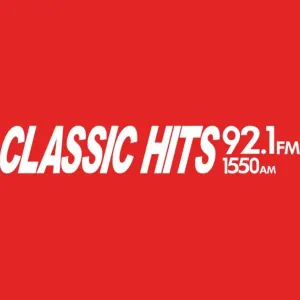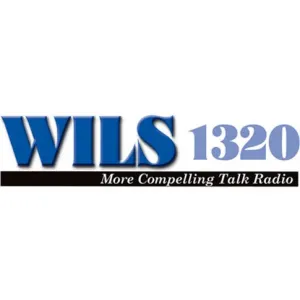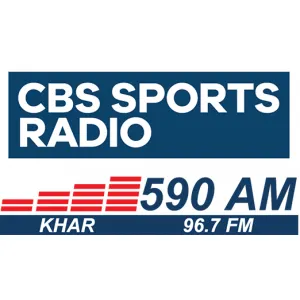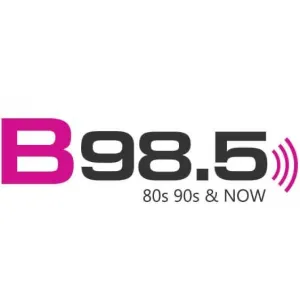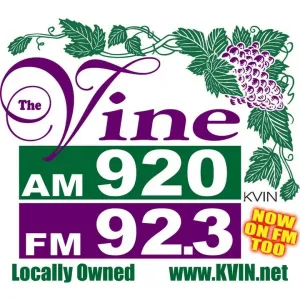Radio KDTH-AM (Voice of the Tristates)
0
Deel
0
0
[
Luister live
]KDTH AM 1370 is an AM radio station based in Dubuque, Iowa. The station is owned by Radio Dubuque. KDTH is a "full service" local radio station with a fulltime news department, sports director, farm director and staff of local personalities, many whom have been part of the Dubuque radio scene for more than 30 years. Its transmitter and towers are located across the Mississippi River from Dubuque in East Dubuque, Illinois just south of the U.S. 20 Bridge. The daytime signal is 5 kilowatts non-directional utilizing one tower while the nighttime s... Bekijk meer
Dubuque AM|1370
(563)690-1370
[email protected]
AM 1370 KDTHRadio Dubuque Inc.346 W. 8th St.PO Box 659Dubuque, IA 52004-0659
http://www.kdth.com
Ansichten:
13Empfohlene Radiosender:
KDTH AM 1370 is an AM radio station based in Dubuque, Iowa. The station is owned by Radio Dubuque. KDTH is a "full service" local radio station with a fulltime news department, sports director, farm director and staff of local personalities, many whom have been part of the Dubuque radio scene for more than 30 years. Its transmitter and towers are located across the Mississippi River from Dubuque in East Dubuque, Illinois just south of the U.S. 20 Bridge. The daytime signal is 5 kilowatts non-directional utilizing one tower while the nighttime signal is 5000 watts directional utilizing all four towers on-site to direct the signal primarily to the north.
On Sunday, May 4, 1941 KDTH began broadcasting. The station was housed at 8th and Bluff Streets in Dubuque - where it has remained to this day[update]. The station broadcast with 1000 watts. The transmitter was located in East Dubuque, Illinois, and it featured a three tower array.
The station became established as an important news and information source in the Dubuque area. People like Bob Gribben, Betty Thomas, Gerald “Red” McAleece, and Gordon Kilgore became familiar names to a large part of the population.
The Beginning It was a sunny Sunday morning, May 4, 1941 when AM 1370 KDTH signed on the air for the first time. The call letters K D T H were representative of the ownership, the Dubuque Telegraph Herald. Newspaper ownership spared no expense in providing a state of the art facility for the staff of 15 men and women employed to bring a new level of excellence to Dubuque broadcasting. The new two story brick building constructed at 8th & Bluff was designed by the local engineering firm of Cullen and Bartels to isolate all outside sound. Walls on the main floor are 20 inches thick. The original flooring was rubber tile to prevent the sound of scraping shoes from interfering with a broadcast.
A lobby reception area equipped with modern leather and polished chrome chairs led to the three tiered observation room where up to 15 persons could watch programs broadcast in Studio A & B as well as the control room. The large windows were constructed using 3 sound sealed plates of glass.
Announcers and entertainers accessed Studio A through a “sound lock” with 2 inch thick doors weighing 375 pounds each. No outside sound entered the air conditioned studios. The largest studio included a 7 foot grand piano, Hammond Organ with chimes, and ample room for an orchestra. A sound effects table including wind machine, and other devices was mounted on heavy rubber wheels.
The one story brick transmitter building located south of East Dubuque included a 22 ft by 25 ft transmitter room, workshop, storage and furnace room and rest room. A 375 foot tower and two 200 foot towers were constructed in an adjacent flood plain, but the house and base of each were built five feet above the highest high-water mark ever registered. The FCC required a licensed engineer to be on duty whenever the station was on the air.
A staff of 16 fulltime and 2 part time persons worked months to prepare for this first day of broadcasting. General Manager, Ken Gordon, had come to Dubuque from a Chicago station and Program Director Paul Skinner had 10 years of experience before joining the KDTH staff. Sherman Bowen headed the News and Sports departments.
George Freund, then a student at Loras College, was record librarian – keeping track of a collection of more than 5,000 selections in the brand new KDTH music library. Most of these were on 16” transcriptions, playable only on special radio station equipment. George went on to the Armed Forces and returned after the war to eventually become News Director, a position he held until joining the staff of Loras College in 1960. Freund was highly respected, not only in the city of Dubuque, but throughout the state of Iowa. He served as President of the Iowa Broadcast News Association for several years. Several generations remember growing up listening to Paul Harvey at 12noon, followed by KDTH Noontime News with George Freund. The newcast opened with the sound of a steamboat whistle and an announcer saying: The steamboat Potosi rounds the band with another cargo of Potosi and Holiday Beer - bringing you the KDTH Noontime News Edition with George Freund.
At 2pm May 4, 1941 a special dedication program, “Only Yesterday”, written by staff member Arnie Stierman, was broadcast. This original historic drama described the founding of Dubuque. A musical score provided by staff organist Sylvia Johnson and a women’s chorus from Westminster Presbyterian Church added to the professional production. (This recording has been preserved and is being restored for future release by Radio Dubuque.)
Locally produced programs on KDTH besides local news and sports included dramas, comedy, children’s adventure, plus live swing, country and western, polka, folk and classical music. One popular show, “The Mail Bag,” hosted by announcer Sherman Bowen, was simply a reading of mail from listeners. More creative programs included “Dinner with the Smiths” – slanted to entertain the large farm audience with agricultural news and live country music performed by Dubuque musicians “Whitey Woelk”, “Texas Red” and Clarence Zahina.
Network programming came to KDTH via the Mutual Radio Network with popular programs like “The Lone Ranger” and “The Shadow.” One locally produced KDTH program became so popular that it was soon broadcast to the entire nation. “The Junior Musicale” featured musical performances by young Dubuque musicians and singers including Kay Wareham, Charles Serena, Heine and Butch Rastatter, Jack Rhomberg, Jimmy Hayes and Bob Gribben. When the program went off the air Gribben stayed on as an office boy, then musical director, staff organist, and eventually program director. Read more about him in a later update.
Live “remote” broadcasts were common, even in those early days of KDTH. May 24, 1941 the station broadcast from Platteville for the Diamond Jubilee celebration of the Wisconsin State Teachers College, now UW-Platteville.
In early June the station broadcast a live concert by the original Dubuque Symphony Orchestra from the Loras College Rock bowl stadium. Soon broadcasts were originating nightly with organist Jerry Chandler from the popular Circle Supper Club in East Dubuque and the Bill Beck orchestra from The Hilltop Casino – the inspiration for “Hernando’s Hideaway” in Broadway show “Pajama Game.” Live broadcasts from beautiful Melody Mill Ballroom were heard several times each week
The KDTH Barn Dance - In 1943 the husband and wife team of Mack and Sandy Ford joined the KDTH staff. They were professional actors and musicians who had traveled the country but took a liking to Dubuque. Their 11:30 weekday “Family Circle” program of music and conversation became very popular. One day Mack decided to create a “Barn Dance” show similar in format to the “Grand Ole Opry.” The first show was scheduled for 9pm on a Saturday night in March 1944 from Studio A. By 6:45pm the limited space of Studio A was full and the observation room was overflowing. By 8:30 the standing room only crowd in the lobby and reception area overflowed to 8th street and around the corner down Bluff. The show started late as engineers scrambled to set up speakers outside to accommodate the crowd.
Within a few weeks arrangements were made to move the show to the beautiful Melody Mill Ballroom north of Dubuque on Highway 52. It was Iowa’s largest ballroom and was often filled to capacity with more than 2,000 fans that paid 60 cents each to attend. On the first night a two mile long string of cars jammed the highway. The KDTH Barn Dance included a cast of 16 including announcer Karl Anthony, comedian “Skinny” Strader, Kay Kody, Texas Red, The Sunshine Sisters, Uncle Fiddlin Charlie, Mack and Sandy and The Barn Stormers Band lead by Clarence Zahina. It was a unique, colorful program the likes of which Dubuque radio hasn’t experienced since.
Bob Gribben - "Gator the Record Rater"Bob Gribben began his career as a boy vocalist and organist with the “Junior Musicale” program on KDTH. When that show left the air he stayed on working as an office boy, then became music director and staff organist and eventually Program Director of KDTH. Bob’s musical talents were displayed Monday through Friday at 11:45 on the “Rainbow of Musical Moods” program that featured his keyboard skills on the Studio A Hammond organ, grand piano and electronic chimes. At Christmas time the program often originated from the mezzanine at Roshek’s Department store (Dubuque Building) where dozens of fans would assemble to enjoy a program of live music.
The music format of the station consisted of more conservative pop favorites by Frank Sinatra, Patti Page, Ray Anthony and similar acts. Bob had observed the growing popularity among young people of the new “rock ‘n roll” music and in about 1954 convinced station management to allow him just 1 hour a day to this new “fad.” “The 5:05 Show” opened with what became a familiar theme song to thousands of KDTH listeners – “The Buck Dance” by David Carroll’s Orchestra, and then transitioned into 55 minutes of Bill Haley, Little Richard, Elvis and the other top favorites of the day. It quickly became the most popular program on the air and soon the music format of the station adapted to include more “rock” in all deejay programs. The KDTH Top 25 Survey was published each week based on actual record sales at Stampfers, Roshek’s, Reniers and several other stores selling both 78 and the new 45rpm singles. Bob also checked juke box plays at popular teen gather places like “The Goats” and “The Q.”
Bob Gribben was to Dubuque what Dick Clark was to Philadelphia. The Sunday morning “Top 25 Countdown” got teens to early church services so they wouldn’t miss the 9:30-12n show which culminated in the #1 song of the week. During each show he’d also play new releases that came in during the week. And, since Bob would rate them on how he believed they’d do on the charts, he became “Gator, the Record Rater” in the teen slang of the era.
Teen dances of the 50s were usually held at school gyms and featured swing combos or big bands that were favored by the teachers and parents. Live bands playing teen music were few in number until later in the decade so Bob started promoting teen dances with records on weekend evenings throughout the tri-state area. “The Bob Gribben KDTH Teen Hops” attracted hundreds of fans whether they were held in Dubuque, Dyersville, Galena, Platteville, Mineral Point, or any community where KDTH could be heard. “Gator” always took along his portable recording equipment and interviewed teens at the dances. These interview became Sunday afternoon re-broadcasts that recreated the fun and excitement of the dance for everyone in attendance and all those we wished they were.
In the winter months he’d broadcast live on a Saturday afternoon from the Allison-Henderson Iced Rink. On summer afternoons he’d be at the Municipal Pool, or promoting an event with the Dubuque Water Ski Club. Bob was a master of promotion and community relations.
After deciding to leave radio in the early 1970s he was hired by John Deere Dubuque Works as a Media Producer. He eventually moved to their headquarters in Moline where he continued working for more than 20 years. He retired to Florida in 1992, and died there on September 19, 1999. He is buried in Mt. Cavalry Cemetery in Dubuque, Iowa.
Interesting bit of trivia: Bob Gribben and fellow KDTH radio personality Gerald "Red" McAleece were cousins.
On Sunday, May 4, 1941 KDTH began broadcasting. The station was housed at 8th and Bluff Streets in Dubuque - where it has remained to this day[update]. The station broadcast with 1000 watts. The transmitter was located in East Dubuque, Illinois, and it featured a three tower array.
The station became established as an important news and information source in the Dubuque area. People like Bob Gribben, Betty Thomas, Gerald “Red” McAleece, and Gordon Kilgore became familiar names to a large part of the population.
The Beginning It was a sunny Sunday morning, May 4, 1941 when AM 1370 KDTH signed on the air for the first time. The call letters K D T H were representative of the ownership, the Dubuque Telegraph Herald. Newspaper ownership spared no expense in providing a state of the art facility for the staff of 15 men and women employed to bring a new level of excellence to Dubuque broadcasting. The new two story brick building constructed at 8th & Bluff was designed by the local engineering firm of Cullen and Bartels to isolate all outside sound. Walls on the main floor are 20 inches thick. The original flooring was rubber tile to prevent the sound of scraping shoes from interfering with a broadcast.
A lobby reception area equipped with modern leather and polished chrome chairs led to the three tiered observation room where up to 15 persons could watch programs broadcast in Studio A & B as well as the control room. The large windows were constructed using 3 sound sealed plates of glass.
Announcers and entertainers accessed Studio A through a “sound lock” with 2 inch thick doors weighing 375 pounds each. No outside sound entered the air conditioned studios. The largest studio included a 7 foot grand piano, Hammond Organ with chimes, and ample room for an orchestra. A sound effects table including wind machine, and other devices was mounted on heavy rubber wheels.
The one story brick transmitter building located south of East Dubuque included a 22 ft by 25 ft transmitter room, workshop, storage and furnace room and rest room. A 375 foot tower and two 200 foot towers were constructed in an adjacent flood plain, but the house and base of each were built five feet above the highest high-water mark ever registered. The FCC required a licensed engineer to be on duty whenever the station was on the air.
A staff of 16 fulltime and 2 part time persons worked months to prepare for this first day of broadcasting. General Manager, Ken Gordon, had come to Dubuque from a Chicago station and Program Director Paul Skinner had 10 years of experience before joining the KDTH staff. Sherman Bowen headed the News and Sports departments.
George Freund, then a student at Loras College, was record librarian – keeping track of a collection of more than 5,000 selections in the brand new KDTH music library. Most of these were on 16” transcriptions, playable only on special radio station equipment. George went on to the Armed Forces and returned after the war to eventually become News Director, a position he held until joining the staff of Loras College in 1960. Freund was highly respected, not only in the city of Dubuque, but throughout the state of Iowa. He served as President of the Iowa Broadcast News Association for several years. Several generations remember growing up listening to Paul Harvey at 12noon, followed by KDTH Noontime News with George Freund. The newcast opened with the sound of a steamboat whistle and an announcer saying: The steamboat Potosi rounds the band with another cargo of Potosi and Holiday Beer - bringing you the KDTH Noontime News Edition with George Freund.
At 2pm May 4, 1941 a special dedication program, “Only Yesterday”, written by staff member Arnie Stierman, was broadcast. This original historic drama described the founding of Dubuque. A musical score provided by staff organist Sylvia Johnson and a women’s chorus from Westminster Presbyterian Church added to the professional production. (This recording has been preserved and is being restored for future release by Radio Dubuque.)
Locally produced programs on KDTH besides local news and sports included dramas, comedy, children’s adventure, plus live swing, country and western, polka, folk and classical music. One popular show, “The Mail Bag,” hosted by announcer Sherman Bowen, was simply a reading of mail from listeners. More creative programs included “Dinner with the Smiths” – slanted to entertain the large farm audience with agricultural news and live country music performed by Dubuque musicians “Whitey Woelk”, “Texas Red” and Clarence Zahina.
Network programming came to KDTH via the Mutual Radio Network with popular programs like “The Lone Ranger” and “The Shadow.” One locally produced KDTH program became so popular that it was soon broadcast to the entire nation. “The Junior Musicale” featured musical performances by young Dubuque musicians and singers including Kay Wareham, Charles Serena, Heine and Butch Rastatter, Jack Rhomberg, Jimmy Hayes and Bob Gribben. When the program went off the air Gribben stayed on as an office boy, then musical director, staff organist, and eventually program director. Read more about him in a later update.
Live “remote” broadcasts were common, even in those early days of KDTH. May 24, 1941 the station broadcast from Platteville for the Diamond Jubilee celebration of the Wisconsin State Teachers College, now UW-Platteville.
In early June the station broadcast a live concert by the original Dubuque Symphony Orchestra from the Loras College Rock bowl stadium. Soon broadcasts were originating nightly with organist Jerry Chandler from the popular Circle Supper Club in East Dubuque and the Bill Beck orchestra from The Hilltop Casino – the inspiration for “Hernando’s Hideaway” in Broadway show “Pajama Game.” Live broadcasts from beautiful Melody Mill Ballroom were heard several times each week
The KDTH Barn Dance - In 1943 the husband and wife team of Mack and Sandy Ford joined the KDTH staff. They were professional actors and musicians who had traveled the country but took a liking to Dubuque. Their 11:30 weekday “Family Circle” program of music and conversation became very popular. One day Mack decided to create a “Barn Dance” show similar in format to the “Grand Ole Opry.” The first show was scheduled for 9pm on a Saturday night in March 1944 from Studio A. By 6:45pm the limited space of Studio A was full and the observation room was overflowing. By 8:30 the standing room only crowd in the lobby and reception area overflowed to 8th street and around the corner down Bluff. The show started late as engineers scrambled to set up speakers outside to accommodate the crowd.
Within a few weeks arrangements were made to move the show to the beautiful Melody Mill Ballroom north of Dubuque on Highway 52. It was Iowa’s largest ballroom and was often filled to capacity with more than 2,000 fans that paid 60 cents each to attend. On the first night a two mile long string of cars jammed the highway. The KDTH Barn Dance included a cast of 16 including announcer Karl Anthony, comedian “Skinny” Strader, Kay Kody, Texas Red, The Sunshine Sisters, Uncle Fiddlin Charlie, Mack and Sandy and The Barn Stormers Band lead by Clarence Zahina. It was a unique, colorful program the likes of which Dubuque radio hasn’t experienced since.
Bob Gribben - "Gator the Record Rater"Bob Gribben began his career as a boy vocalist and organist with the “Junior Musicale” program on KDTH. When that show left the air he stayed on working as an office boy, then became music director and staff organist and eventually Program Director of KDTH. Bob’s musical talents were displayed Monday through Friday at 11:45 on the “Rainbow of Musical Moods” program that featured his keyboard skills on the Studio A Hammond organ, grand piano and electronic chimes. At Christmas time the program often originated from the mezzanine at Roshek’s Department store (Dubuque Building) where dozens of fans would assemble to enjoy a program of live music.
The music format of the station consisted of more conservative pop favorites by Frank Sinatra, Patti Page, Ray Anthony and similar acts. Bob had observed the growing popularity among young people of the new “rock ‘n roll” music and in about 1954 convinced station management to allow him just 1 hour a day to this new “fad.” “The 5:05 Show” opened with what became a familiar theme song to thousands of KDTH listeners – “The Buck Dance” by David Carroll’s Orchestra, and then transitioned into 55 minutes of Bill Haley, Little Richard, Elvis and the other top favorites of the day. It quickly became the most popular program on the air and soon the music format of the station adapted to include more “rock” in all deejay programs. The KDTH Top 25 Survey was published each week based on actual record sales at Stampfers, Roshek’s, Reniers and several other stores selling both 78 and the new 45rpm singles. Bob also checked juke box plays at popular teen gather places like “The Goats” and “The Q.”
Bob Gribben was to Dubuque what Dick Clark was to Philadelphia. The Sunday morning “Top 25 Countdown” got teens to early church services so they wouldn’t miss the 9:30-12n show which culminated in the #1 song of the week. During each show he’d also play new releases that came in during the week. And, since Bob would rate them on how he believed they’d do on the charts, he became “Gator, the Record Rater” in the teen slang of the era.
Teen dances of the 50s were usually held at school gyms and featured swing combos or big bands that were favored by the teachers and parents. Live bands playing teen music were few in number until later in the decade so Bob started promoting teen dances with records on weekend evenings throughout the tri-state area. “The Bob Gribben KDTH Teen Hops” attracted hundreds of fans whether they were held in Dubuque, Dyersville, Galena, Platteville, Mineral Point, or any community where KDTH could be heard. “Gator” always took along his portable recording equipment and interviewed teens at the dances. These interview became Sunday afternoon re-broadcasts that recreated the fun and excitement of the dance for everyone in attendance and all those we wished they were.
In the winter months he’d broadcast live on a Saturday afternoon from the Allison-Henderson Iced Rink. On summer afternoons he’d be at the Municipal Pool, or promoting an event with the Dubuque Water Ski Club. Bob was a master of promotion and community relations.
After deciding to leave radio in the early 1970s he was hired by John Deere Dubuque Works as a Media Producer. He eventually moved to their headquarters in Moline where he continued working for more than 20 years. He retired to Florida in 1992, and died there on September 19, 1999. He is buried in Mt. Cavalry Cemetery in Dubuque, Iowa.
Interesting bit of trivia: Bob Gribben and fellow KDTH radio personality Gerald "Red" McAleece were cousins.
© LogFM.com, 2009-2025 (2025-12-15,06:39:37)
